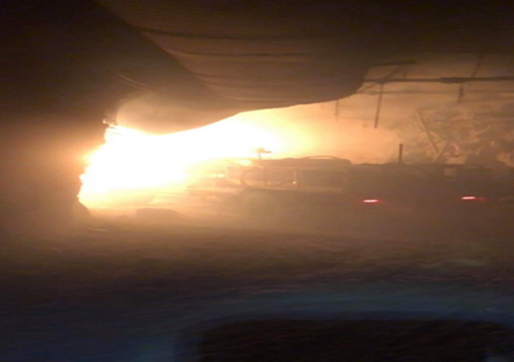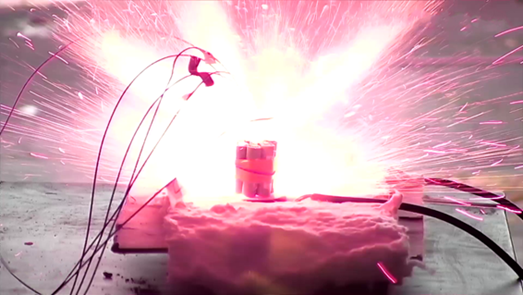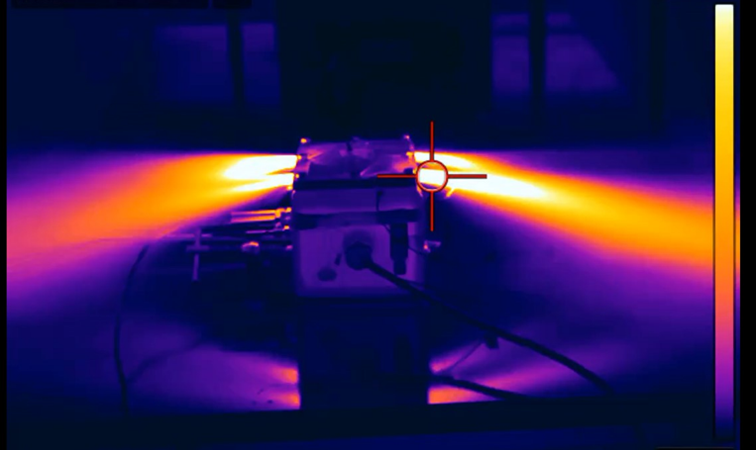Mining Project: Methods to Mitigate Fire and Explosion Hazards of Lithium-ion Batteries
| Principal Investigator |
|
|---|---|
| Start Date | 10/1/2022 |
| End Date | 9/30/2023 |
| Objective |
Battery electric vehicle development for underground mining continues at a rapid pace. From a diesel emissions reduction perspective, the benefits of employing battery electric vehicles (BEVs) are arguably greater for underground mining than any other industry. However, lithium-ion batteries are made from flammable materials and have the potential to introduce fire and explosion hazards. Several incidents have occurred in underground mines in the early stages of BEV deployment, emphasizing the ongoing need to mitigate fire and explosion hazards. For gassy mine applications, the mining industry has unresolved questions about the potential for pressurized explosions within explosion-proof enclosures containing lithium-ion batteries. |
| Topic Areas |
Research Summary
Approach
Researchers conducted a lithium-ion battery thermal runaway test, within a modified MSHA-approved XP enclosure, to assess thermal runaway containment. The thermal runaway observed in this test produced jet flames emanating from the cover joint at several locations, which distorted the cover joint and bottom plate of the enclosure beyond allowable limits per the U.S. Code of Federal Regulations. The test demonstrated that XP enclosures may not provide adequate explosion protection against lithium-ion battery thermal runaway, and additional research is needed to investigate the potential approaches to mitigate the hazards that were suggested as part of this project. This pilot project also investigated methods to analyze hydrogen fluoride and other gas emissions from battery fires and identified gaps in equipment requirements and standards related to environmental conditions such as impact and vibration.
Milestones and Accomplishments
| Description | Audience | Year |
|---|---|---|
| Thermal runaway-generated pressure and enclosure volume dependency findings will be used to revise an international safety standard for explosion-protected equipment. | Explosion-protected equipment manufacturers | 2024 |
Planned Impacts and Outcomes
The research informs industry-wide efforts to mitigate large-scale BEV fires and explosions. Thermal runaway experiments demonstrated that explosion-proof enclosure assessment criteria should be enhanced to mitigate excessive over-pressures and temperatures. Some approaches to mitigate the hazards were suggested. This pilot project supported the development of two new research projects, funded in fiscal year 2024: “Characterizing the Generation and Mitigation of Hazardous Gases during Lithium-ion Battery Failure Events” and “Environmental Susceptibility of Mine Utility Vehicle and Rubber-tired Mantrip Lithium-ion Batteries.”
Outputs
Brown CB, Dubaniewicz TH, Barone TL, Thomas RA [2024]. Thermal runaway pressures as a function of free space in sealed containers for lithium titanate cells. Manuscript submitted for the SME Annual Meeting 2024, Phoenix AZ.
Dubaniewicz [2024]. Explosion-proof enclosure failure to contain a lithium-ion battery thermal runaway. Manuscript submitted for the SME Annual Meeting 2024, Phoenix AZ.
Dubaniewicz TH, Barone TL, Brown CB, Thomas RA [2022]. Comparison of thermal runaway pressures within sealed enclosures for nickel manganese cobalt and iron phosphate cathode lithium-ion cells. J Loss Prev Pro Ind 76:104739.
Rayyan N, Brown C, Dubaniewicz T H [2023]. Thermal runaway of LTO and NCA lithium-ion batteries in a sealed enclosure containing methane. SME Annual Meeting Preprint 23-043, Denver CO, March 1.
Tang W, Yuan L, Thomas R, Soles J [2023]. Comparison of fire suppression techniques on lithium-ion battery pack fires. Min Metal Expl 40:1081–1087
Supporting Visuals

Several incidents have occurred in underground mines in the early stages of BEV deployment. Photograph taken by a worker trapped inby a BEV fire.

Experimental characterization of lithium-ion battery thermal runaway phenomena to develop recommendations to mitigate fire and explosion hazards.

An explosion-proof enclosure failed to contain a lithium-ion battery thermal runaway. Some approaches to mitigate the hazard were suggested.
- Determining the Root Causes of Flame Cutting and Welding Fires in Underground U.S. Coal Mines
- Evaluation of the Bagged Stone Dust Barrier Effectiveness in a Bord and Pillar Mine
- Explosion Temperatures and Pressures of Metals and Other Elemental Dust Clouds
- Initial Study of Buried Communication Cable for Underground Mines
- Mitigating Fire and Explosion Hazards of Lithium-ion Batteries
- Rapid (Grab) Sampling During Full-scale Explosions - Microscopic and Analytical Evaluation
- Reducing the Fire and Explosion Hazards of Flame-Cutting and Welding in Underground Coal Mines
- Remotely Installed Mine Seals for Mine Fire Control
- A Review of Recent Accidents Involving Explosives Transport
- The Role of ASTM E27 Methods in Hazard Assessment: Part II - Flammability and Ignitability
- U.S. Bureau of Mines Technology Applicable to Disaster Response, Urban Search And Rescue